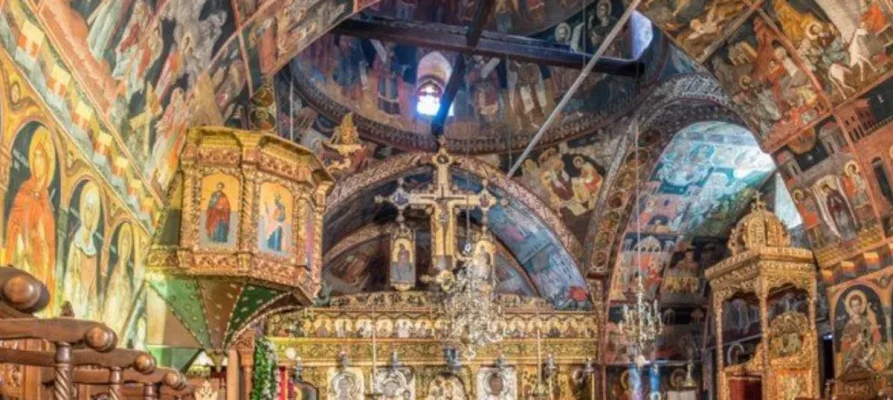Church of the Holy Virgin
Church of the Holy Virgin
There’s a gem that often gets overshadowed by the grandeur of the Acropolis of Lindos. I’m talking about the Church of the Holy Virgin, or as the locals fondly call it, Panagia.
Now, if you’re thinking, “Another church? I’ve seen dozens on my travels,” hold onto your hat because the Church of the Holy Virgin in Lindos is not just any church. It’s a testament to the rich tapestry of history that Rhodes has been a part of.
Built in the 14th century, this Church stands as a silent witness to the many changes that Lindos village and the entire island of Rhodes have undergone. But who was behind this architectural marvel? It was the Knights of Saint John, those medieval knights who weren’t just about jousting and feasting. They had a knack for building structures that stood the test of time. And the Church of the Holy Virgin is a prime example of their craftsmanship.
Why did they build it? Well, churches on Rhodes were not just places of worship. They were symbols of faith, power, and a commitment to preserving Christian traditions in the face of numerous challenges. The Church of the Holy Virgin was built as a beacon of hope and a place for the people of Lindos village to find solace and strength.
Now, I know what you’re thinking. “That’s all well and good, but what’s in it for me?” Fear not, for the Church of the Holy Virgin is not just a feast for the soul but also for the eyes.
As you step inside, prepare to be awestruck by the stunning frescoes that adorn its walls. These aren’t your run-of-the-mill paintings. They tell tales of faith, sacrifice, and the eternal battle between good and evil. And the best part? They’re centuries old, making you wonder about the talented hands that created them and the countless souls that have stood where you stand, equally captivated.
Once you’ve had your fill of the interiors, step outside and bask in the serenity of the Church’s courtyard. And while you’re at it, don’t forget to look up and admire the bell tower. It’s not just a structure to house bells; it’s an architectural marvel in its own right. And if you’re lucky, you might just hear the bells chime, their melodious notes echoing through Lindos village, reminding everyone of the beauty that is the Church of the Holy Virgin.
So, the next time you find yourself in Rhodes, wondering about the top things to do, remember that while the beaches and bars are enticing, a piece of history is waiting for you in Lindos village. A church that’s not just about bricks and mortar but about stories, faith, and a testament to the indomitable spirit of the people of Rhodes.
Once you’ve had your fill of the Church of the Holy Virgin and are now itching to explore more of what Rhodes has to offer, well, you’re in luck. This island isn’t just about sun, sea, and sand. It’s also home to some of the most captivating historical sites that’ll make you feel like you’ve stepped into a time machine.
Lindos Acropolis
Perched high above Lindos village, the Acropolis isn’t just a site; it’s a sight with panoramic views of the shimmering Aegean Sea and the village below. It’s the perfect spot for those Insta-worthy snaps. But it’s not all about Instagram. This ancient citadel is steeped in history, and as you wander its ruins, you’ll be walking in the footsteps of ancient Greeks, Romans, and the Knights of Saint John.
Filerimos Monastery
Nestled atop the Filerimos hill, this monastery is a serene escape from the hustle and bustle. But don’t let its tranquillity fool you. Behind its peaceful façade lies a history of battles, conquests, and faith. And if you’re up for a bit of a climb, the Way of the Cross leading up to the monastery offers a spiritual journey with some seriously stunning views.
Tsambika Monastery
Legend has it that if you want to be blessed with a child, a visit to Tsambika Monastery might do the trick. Perched on a hilltop, this sacred site is dedicated to the Virgin Mary and offers panoramic coastline views. But it’s not just about the views or the legends. The serenity and spiritual energy here are palpable, making it a must-visit for those seeking a moment of reflection or a touch of the divine. Plus, the journey up is a great way to work off all those holiday treats.
But what if you’re wheeling around or have a bit of a wobble in your walk? Does that mean you’ll miss out on this slice of Rhodes’ history? Absolutely not. Let me break down the nitty-gritty of accessibility at this iconic spot.
Lindos village, with its charming cobbled streets, might seem challenging for those with mobility issues. But the locals and the authorities have been working their socks off to ensure that everyone, regardless of their mobility, gets a fair shot at experiencing the wonders of this ancient Church.
The main entrance to the Church of the Holy Virgin is relatively flat, with only a slight incline. There’s a sturdy handrail to hold onto if you need extra support. And for our friends on wheels? There’s a ramp to ensure a smooth roll into the Church. No bumps, no fuss.
Inside, the Church is spacious, allowing for easy manoeuvrability. Whether on crutches, using a walking stick, or in a wheelchair, you’ll find ample space to explore without feeling cramped. And those mesmerising frescoes? They’re at a height that ensures everyone gets an eyeful, regardless of whether you’re standing tall or sitting pretty.
Now, let’s talk toilets. Because, let’s face it, when nature calls, it doesn’t care if you’re in the middle of a historical epiphany. The Church has accessible toilets with grab rails and enough space for easy transfers.






